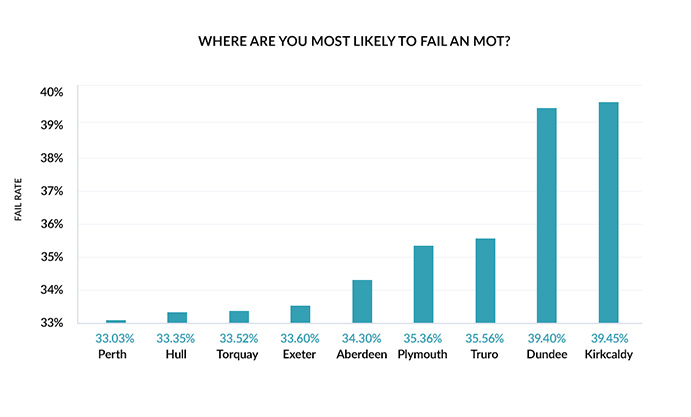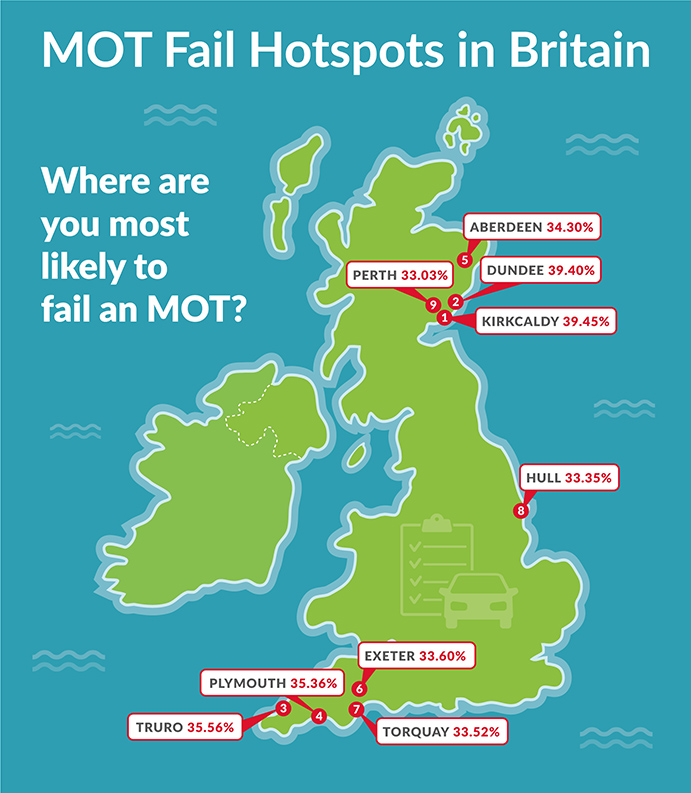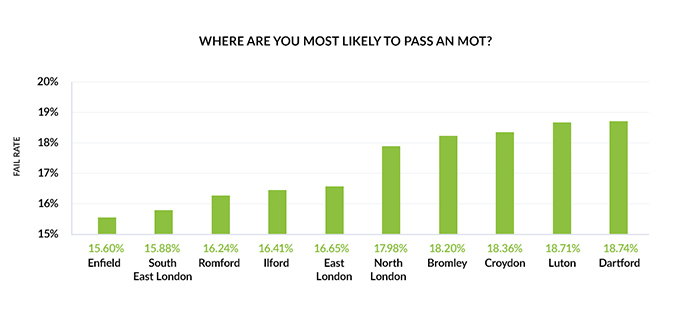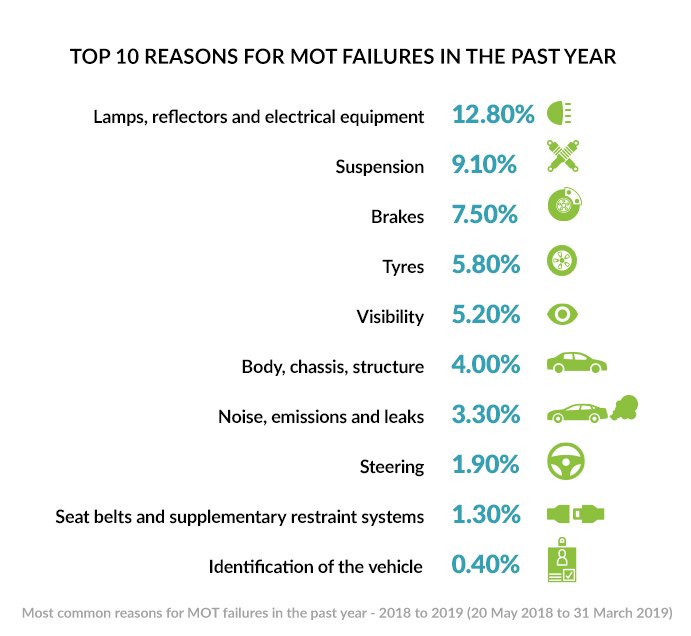Nearly 40% of drivers fail their MOTs in Kirkcaldy and Dundee – the highest fail rates in the country.
Those living in Enfield and South London are most likely to pass their MOT, with less than a 16% fail rate – the lowest in the UK.
Here at CarTakeBack UK, we investigated the best and worst regions for MOT pass rates, and it showed surprising patterns. The top pass rates are all in South-East England, and on the flip side, the highest fail rates fall in Scotland.
We analysed the government research and found some alarmingly high fail rates in Kirkcaldy (39.45%) and Dundee (39.4%). Over 1 in 3 motorists are bound for an MOT failure in these areas.
Truro, Plymouth, Aberdeen, Exeter, Torquay and Hull didn’t fare much better, all with similarly poor pass rates.
In better news, drivers in the London and Essex regions are most likely to pass their MOT with flying colours. This area of Britain fills pretty much all the top spots, displaying the UK’s best pass rates.
How can there be such a divide across Britain? It’s more than likely down to a difference in lifestyles. Motorists in Scotland will be living far more remotely than those near the capital. London based drivers are likely to do far less miles between MOT tests, leading to less motor problems overall.
Generally, London and its surrounding areas are the richest regions, giving them more opportunities to keep their motors maintained and in consistently fine working order.



We’ve also investigated the main reasons for MOT failures in Britain.
12.8% of MOT fails are down to problems with lamps, reflectors and electrical equipment.
Nearly 1 in 10 fail an MOT due to suspension.
Research from SMMT indicates that “around 1.5 million vehicles fail their MOT each year as a result of simple issues such as faulty bulbs, too little tyre tread, or even empty windscreen washer fluid bottles – small repairs that could have been easily identified by the owner prior to the annual test.”

Here at CarTakeBack.com, we’ve focused on the top 5 reasons cars fail and given our expert tips on how you can avoid them:
Lamps, reflectors and electrical equipment – 12.8%
Over 1 in 10 cars fail because of their lighting and electronics. Sometimes it’s blown bulbs and headlights, side lights, rear lights, brake lights etc. not working.
HOW TO AVOID A FAIL: Test all of the lights before the MOT to check they all function properly. If one isn’t working, plan ahead and buy a replacement bulb – the garage should be able to fit this for you before your MOT.
Also, avoid failing due to low lighting too by removing any stickers from where light is emitted.
Suspension – 9.1%
Nearly 10% of cars fail due to their suspension. With a few simple checks, you can attempt to spot any suspension issues prior to your test.
HOW TO AVOID A FAIL: There are a few indicators, ask yourself the following:
Can you hear noises during everyday driving, especially when driving over bumps?
Does the car jerk or can you feel every bump on uneven surfaces?
Do you feel a drift or pull as you’re turning?
When your car is parked up, does it sit completely level or are some corners higher and lower?
Push down above each wheel, does it return to its normal level without bouncing?
Issues with any of these could be an indication of a broken shock absorber.
Brakes – 7.5%
Brakes are one of the most vital safety aspects of a car, so they’re a common failure on an MOT.
If you hear squealing or grinding whilst you break, there’s a good chance your brake pads are running low and coming to the end of their life.
HOW TO AVOID A FAIL: To pass an MOT inspection, brake pads must be at least 1.5mm thick. If you think yours may be too low, get them checked before the test.
Handbrakes are another big failure in this category. When you put on your handbrake at a hill, does it keep the car in place?
Check your brake lights work beforehand – press the pedal and ask someone to check the rear brake lights are working.
Tyres – 5.8%
Tyre tread depth is the fourth common MOT failure. As the only part of the car to actually touch the road, they’re top condition is imperative for car safety.
HOW TO AVOID A FAIL: Here’s how to check your tyre tread depth:
Firstly make sure your car is at a standstill and the ignition is off. The UK government requires that a car tyre’s tread depth should be a minimum of 1.6mm (but it’s recommended that these should actually be around 3mm) across the central three quarters of the tyre. 20p coins are perfect for checking.
Insert a 20p coin into the tyre tread, and you can still see the outer edge, the tread is too low and you will fail your MOT.
For an even more accurate check, you can use a manual or digital tyre depth gauge.
Visibility – 5.2%
The MOT test evaluates anything affecting the driver’s view of the road for example, wipers, washers and the condition of the windscreen.
HOW TO AVOID A FAIL: Check the view from the driving seat – is there any damage on the windscreen larger than 40mm? Or any damage wider than 10mm in the ‘swept’ part in front of the driving seat?
If so, these will both be a fail and need sorting pre-MOT.
Also, remove any stickers, toys or air fresheners that could impact your view.
Do your windscreen wipers still keep your windscreen clean? Damage such as tears in the rubber of the wipers could cause a fail.
Lastly, make sure your screenwash bottle is full before the test!
Even more ways to avoid a fail:
Number plate
Ensure your number plate at the front and back is clean and legible. Give it a quick clean before you take it in!
Seatbelts
All of your seatbelts should be in solid, working order. Sharply tug on them all to check they react as you’d expect in a severe breaking situation.
Seats
Check the driver’s seat mechanics allow movement backwards and forwards.
Horn
Give your horn a blast – if it doesn’t work, get it replaced or repaired by the garage before your test.
Fuel and engine oil
To conduct an MOT, the garage needs a sufficient level of fuel and engine oil to test for emissions. Make sure they’re both full.




